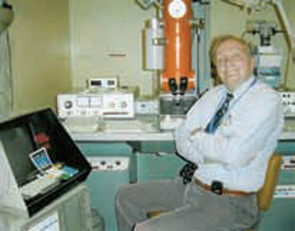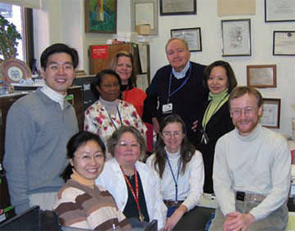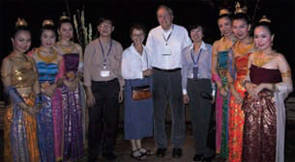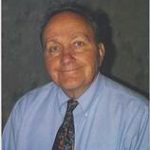Widely published, much honored and admired, H. Ralph Schumacher, Jr., MD, is one of that rare breed, a triple-threat rheumatologist, says rheumatologist and long-time colleague Daniel G. Baker, MD, vice president of clinical immunology at Johnson & Johnson.
Dr. Schumacher’s stature in the field of rheumatology is built on a prodigious body of work, not just in laboratory and clinical investigation, but in his clinical and teaching pursuits. Currently, Dr. Schumacher is professor of medicine at the University of Pennsylvania in Philadelphia; director of rheumatology-immunology research at the VA Medical Center in Philadelphia; and founding editor and current editor-in-chief of the Journal of Clinical Rheumatology, the official journal of the Pan American League of Associations for Rheumatology (PANLAR).
Recent conversations with Dr. Schumacher, several former fellows, and long-time collaborators revealed a man of dedication, discipline, and heart, with an appetite for sharing knowledge.

First and Foremost a Scientist
Five hundred fifty and still counting: the list of published journal articles in Dr. Schumacher’s CV is impressive not only for its length but for its breadth and depth of scientific inquiry. “I always thought of Ralph, from the research standpoint, as a really great observational scientist. He’s a keen observer of various types of pathology in arthritis,” notes Edward V. (“Ted”) Lally, MD, professor of medicine and director of rheumatology at Brown Medical School in Providence, R.I., who was a fellow with Dr. Schumacher from 1978–1980.
From pioneering studies using electron microscopy on normal synovium, describing the value of synovial biopsy in diagnosis; to investigations on monosodium urate, calcium pyrophosphate dihydrate, and apatite crystal pathogenesis in synovial fluid and synovium; to reports of the histology of very early synovitis; to a just-completed study of acupuncture in arthritis, Dr. Schumacher’s body of work is impressive for its range.1-3 “He is open to everything,” comments Joshua Baker, MD, a current fellow in the division of rheumatology at the University of Pennsylvania and Dr. Daniel Baker’s son. “The main thing about Dr. Schumacher is that he is, first and foremost, a scientist in the best sense of the word. He will not listen to a case without having a healthy level of skepticism about each part of it.”
The senior Dr. Baker concurs, saying, “My most vivid impression of Ralph was his dedication to science. That’s what he did: he was going to explore and study things, and he was persistent and relentless in his pursuit.” After his own fellowship at Penn, Dr. Baker joined the faculty and collaborated with Dr. Schumacher at the VA for another 17 years.

Following Threads of Discovery
Dr. Schumacher’s intellectual curiosity and drive blossomed early in his career, although he had no idea that rheumatology would be his choice when he attended medical school at the University of Pennsylvania School of Medicine. Two electives—one spent in a Cachiquel-speaking Guatemalan village researching cures for Kwashiorkor, and another as an extern at the Talihina Indian Hospital in Oklahoma—were life-changing experiences. “Both of those experiences,” he recalls, “showed me patients’ suffering in these underserved populations and the scientific challenges [of finding cures for and treating disease].” They also sparked his interest in other cultures, demonstrated by the international pool of fellows and his longstanding collaborations with international rheumatology societies.
He did his residency and initial rheumatology fellowship at the Wadsworth VA Hospital in Los Angeles and the University of California, Los Angeles Medical Center. While stationed at Travis Air Force Base from 1963–1965, Dr. Schumacher established a relationship with Ephraim Engelman, MD, chief of rheumatology at the University of California, San Francisco (UCSF), who, he says, “was willing to let a ‘young punk’ with just one year of fellowship” drive from the Air Force Base just outside Fairfield, Calif., to the UCSF lab to continue his investigations into the arthritis-complicating hemochromatosis that had been the subject of one of his first papers.
Following his military service, it was on to another fellowship in rheumatology at Robert Breck Brigham Hospital and Harvard Medical School, both in Boston, where he learned electron microscopy from basic scientist Guido Majno, MD. And that, says Dr. Schumacher, was a major “A-ha!” scientific moment for him. He had latched onto the idea of investigating the pathology of the joint earlier while at the Wadsworth VA with Carl Pearson, MD, who was “looking mostly at muscle, but who was very influential for me,” he says. But it was in Boston that Dr. Schumacher realized he could utilize the then-new technology of the electron microscope and “look through it at very early arthritis, to try to find out its causes.”
Many of Dr. Schumacher’s research papers emanated from his exploration of the synovium and the synovial fluid in rheumatoid arthritis. But then, as is often the case with scientific discovery, he began discovering other things besides the still-elusive causes of rheumatoid arthritis—such as nucleic acids of Chlamydia and other bacteria in the synovium despite negative cultures in reactive arthritis.4 Dr. Schumacher relentlessly pursued the causes of a host of other diseases throughout his career, including osteoarthritis and other metabolic arthropopathies and endocrinopathies.

A Beehive of Activity
The bulk of that research took place at Penn, Dr. Schumacher’s alma mater, after he joined the faculty in 1967 under Joe Hollander, MD, and was named chief of the arthritis section at the VA Medical Center, a post he held for more than 30 years. He built an effective, stable research team with one technician-collaborator, Gilda Clayburne, MLT, who has now worked with him for 40 years. His faculty and administrative appointments also attest to his multiple talents. He has held professorships in the School of Veterinary Medicine (developing a model for gout in dogs’ knees and studying a spontaneous rheumatoid-like arthritis in dogs); in the department of orthopedic surgery (studying factors involved in joint implant loosening); and was a visiting scholar at National Institute of Arthritis, Musculoskeletal, and Skin Disease from 1994–1999, where he did synovial biopsies and established an early arthritis cohort.
Meanwhile, he continued to build the program at Penn into a world-class research and teaching center. Dr. Schumacher had strong early support for his investigations. Dr. Hollander helped him secure an electron microscope for his own laboratory and he himself successfully garnered grants for his own projects. In 1975 alone, more than 15 papers addressed a range of investigations, from rheumatological manifestations of sickle cell disease, to electron microscopic studies of ear cartilage in relapsing polychondritis, to vitamin B6 levels in rheumatoid arthritis.5-7
And That’s Not Interesting?
During our interview, Dr. Schumacher explained his approach to clinical care. “A good rheumatologist,” he says, “has to spend time with people, because we don’t have abracadabra cures. You may notice that I use the term ‘people’ instead of ‘patients.’ I don’t like the concept that, when we call them patients, somehow they belong to us, that we’re superior.”
Dr. Schumacher’s former fellows valued his clinical and investigatory skills. Joan M. Von Feldt, MD, MSEd, professor of medicine in the division of rheumatology at Penn and a member of The Rheumatologist’s editorial board, was a fellow in 1987. “One of the things I have loved about Ralph is that a patient wasn’t just a patient—every patient might have something that would be worth studying,” she says. “This quality, I think, spoke to his incredible intellectual curiosity and his approach to scientific inquiry. I now try to do the same thing—to have trainees look at patients not just for their clinical care, but how [their condition] can inform us about a diagnosis or a disease that we don’t understand very much about.”
Another former fellow, Eric P. Gall, MD, is currently professor and chair of medicine; chief of rheumatology and immunology; and professor of microbiology and immunology at the Chicago Medical School, Rosalind Franklin University of Medicine and Science. Called for a rheumatology consult his first day as an attending fellow in 1970 at the Philadelphia VA, he saw an older man who had “garden-variety osteoarthritis of the hands,” he says. When he presented the case to Dr. Schumacher, Dr. Gall intimated that the man’s condition was not very interesting—even though he only had osteoarthritis on the second and third fingers of both hands. At the bedside, Dr. Schumacher questioned the man about his occupation. A retiree, the man worked in an amusement park, transporting children in a horse-drawn cart. “And, where do you hold the reins?” asked Dr. Schumacher. The man replied: “Between my second and third fingers.”
At that point, says Dr. Gall, laughing as he recalls the incident, Dr. Schumacher turned to him and said, “So, that’s not interesting? And, by the way, you don’t know how to spell Schumacher!”
Career Timeline
1959–Earns his MD from the University of Pennsylvania
1960–Completes an internship at Denver General Hospital
1962–Completes a residency at Wadsworth VA Hospital in Los Angeles
1963–Completes rheumatology fellowship at Wadsworth VA Hospital and University of California Los Angeles Medical Center
1965–Completes military service at Travis Air Force Base in California
1967–Completes rheumatology fellowship Robert B. Brigham Hospital and Harvard Medical School in Boston
1967–Becomes associate in medicine at the University of Pennsylvania School of Medicine
1967–Becomes chief of the arthritis section of the VA Medical Center in Philadelphia
1969–Becomes assistant professor of medicine at Penn Becomes director of the VA-Penn rheumatology traineeship
1972–Becomes associate professor of medicine at Penn
1975–Becomes associate professor of comparative medicine at Penn’s School of Veterinary Medicine
1979–Becomes professor of medicine at Penn
1985–Becomes adjunct professor of medicine at Drexel University School of Medicine, Philadelphia
1991–Becomes acting chief of rheumatology at Penn
2002–Becomes professor of orthopedic surgery at Penn
Dedicated Mentor
Naomi Schlesinger, MD, chief of rheumatology in the department of medicine at the University of Medicine and Dentistry of New Jersey Robert Wood Johnson Medical School in Piscataway, N.J., says that whenever she thinks of Dr. Schumacher, she pictures him where he could often be found—in his large office, in front of his electron microscope, surrounded by hundreds of manuscripts in brown boxes lined up against the wall. His office door was always open.
During Dr. Lally’s time at Penn, he recalls how encouraging Dr. Schumacher was: “He taught me a lot of organizational skills—things I try to pass on to our fellows [here at Brown University]. The approach to the patient, the exam, and the intellectual and scientific honesty that he passed along to us, I think, were really important. He was probably my biggest influence in rheumatology.”
Dr. Schumacher’s long-time associate, Bonnie Brice Dorwart, MD, notes that, “as well known as Dr. Schumacher is—and he is known the world over—he is totally dedicated to having his fellows do their best.” Dr. Dorwart is former chair of the rheumatology division at Lankenau Hospital in Wynnewood, Pa., and the first female rheumatology fellow at Penn. When she embarked on a study to compare joint fluid and blood samples from patients with a variety of rheumatic conditions, Dr. Schumacher placed signs in the clinics asking fellows to call her about their patients’ joint and blood samples. “Once we had a project,” she recalls, “Ralph was just single minded. He convinced even his private patients—if that person was a candidate for this study—to return to the clinic the next day to collect fluid. Every study we did, he was on point.”
That was the quality that Lan Chen, MD, PhD, a rheumatologist at Penn Presbyterian Medical Center in Philadelphia, was most impressed by when she became a fellow in 2000. “Knowing that he is such a well-known researcher, I was amazed at how involved he is, research-wise,” she says. “He would never say no to even small projects. He really has that zest in doing research!”
He was also nurturing of his fellows. Dr. Schumacher and his wife, Liz, made Dr. Lally and his wife, newcomers to Philadelphia in 1980, feel very welcome, recalls Dr. Lally. “My wife still has fond memories of our time in Philadelphia,” he says. Dr. Schlesinger, too, warmly recalls cookouts held in the Schumacher’s award-winning terraced garden. (Dr. Schumacher and his wife transformed an eroded hillside into what Dr. Schumacher now calls “a fairyland” with garden sculptures from their travels, a fountain, fish pond, and exotic and native plants with all-season interest.)
A Zest for Life, Research, and Collaboration
Former fellows have often remained collaborators with Dr. Schumacher. When he left Penn for the University of Arizona in 1973, Dr. Gall continued to collaborate with Dr. Schumacher. They shared an interest in medical photography and later coauthored an atlas on rheumatoid arthritis, among other projects.
Dr. Schumacher managed to fit in multiple collaborations around his teaching and travel schedule—which was extensive, because he is an honorary member of countless international rheumatism societies.
Dr. Schumacher played basketball and tennis in college and continued for most of his life, participating in an over-30 basketball league and playing with the Penn house staff into his 60s. One picture on his Web site (www.med.upenn.edu/synovium) shows him shooting hoops with his Taiwanese colleagues during his 1979 sabbatical, during which he set up the first rheumatology division in Taiwan. Since 2005, he has spearheaded OMERACT’s Special Interest Groups and their resulting Workshop on Outcome Measures for Acute and Chronic Gout.8
Dr. Schumacher reflects that what initially drew him to research in rheumatology—his initial quest to explore the synovium and find the causes for rheumatoid arthritis and other diseases—remains as an evolving puzzle. A surprise discovery was that even normal joints often have DNA and RNA from Chlamydia (as well as various other infectious agents) lodged in the joint, without causing disease.9 “We’re all exposed to various external insults that can apparently bombard our joints, and I’ve been trying to stimulate people to consider that ‘disease’ probably results from a complicated interaction between the host’s genetically determined variety of responses to various environmental insults, rather than a specific insult itself.”10
Dr. Schumacher’s contributions to the field continue to reverberate, not just in the literature, but through those he has trained. Says Dr. Schlesinger of her fellowship: “There are times in your life that you wish never ended and [my fellowship] was one of those times. Dr. Schumacher expected of you what he expected of himself, which was to work hard. I loved what I did, how he practices, and the crystals! We were lucky to have access to him.”
Gretchen Henkel is writing the “Metrics in Rheumatology” series.
References
- Schumacher HR, Kulka JP. Needle biopsy of the synovial membrane: Experience with the Parker-Pearson technique. N Eng J Med. 1972;286:416-419.
- Agudelo C, Schumacher HR. The synovitis of acute gouty arthritis; A light and electron microscopic study. Human Path. 1973;4:265-279.
- Schumacher HR, Kitridou RC. Synovitis of recent onset: A clinico-pathologic study during the first month of disease. Arthritis Rheum. 1972;15:465-485.
- Gerard HC, Branigan PJ, Schumacher HR, Hudson AP. Synovial Chlamydia trachomatis in patients with reactive arthritis/Reiter’s syndrome are viable but show aberrant gene expression. J Rheumatol. 1998;25:734-742.
- Schumacher HR. Rheumatological manifestations of sickle cell disease and other hereditary hemoglobinathopies. Clinics in Rheum. 1975;1:37-52.
- Shaul SR, Schumacher HR. Relapsing polychondritis. Electron microscopic study of ear cartilage. Arthritis Rheum. 1975;18: 617-625.
- Schumacher HR, Bernhart FW, Gyorgy P. Vitamin B-6 levels in rheumatoid arthritis. Effect of treatment. Am J Clin Nutrit. 1975;28:1200-1203.
- Schumacher HR, Taylor WH, Edwards L, et al. Outcome domains for studies of acute and chronic gout. J Rheumatol. 2009;36:2342-2345.
- Schumacher HR, Arayssi T, Crane M, et al. Chlamydia trachomatis nucleic acids can be found in the synovium of some asymptomatic subjects. Arthritis Rheum.1999;42:1281-1284.
- Schumacher HR. The end of ‘disease’ as a simple concept. Curr Rheumatol Rep. 2000;2:271-272.

